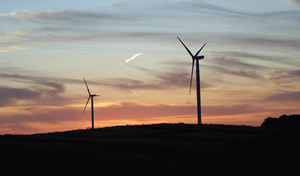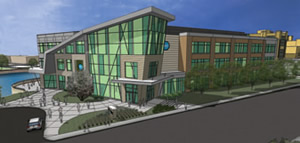Healthy Campus, Healthy Community
- By Brandon Barrett
- 03/01/15

PHOTO COURTESY OF KALAMAZOO VALLEY COMMUNITY COLLEGE
Green, healthy, sustainable — these words have long been used in the world of educational facilities around the country. At Kalamazoo Valley Community College (KVCC) in Michigan, sustainability is a way of life and an educational tool. The college has been making efforts to find sustainable solutions to tough building and facility problems for years. These efforts have paid dividends in terms of energy savings and state funding. What makes KVCC even more unique, however, is an attitude of health and greenness that is informing the creation of a new and innovative campus in downtown Kalamazoo that will be completed in 2015.
Sustainable Beginnings
“Sustainability is really nothing new here,” confirms Dan Maley, director of facilities and construction at KVCC. “Whether through our Sustainable Moves initiative or our work with the Michigan Department of Environmental Quality, we have placed an emphasis on environmental responsibility.” As Maley can attest, the list of environmentally friendly planning features at KVCC is a large and ever-growing collection of innovative ideas and programs. Everything from occupancy-driven lighting to green cleaning methods have been explored and implemented.
The Sustainable Moves Committee is a group of dedicated KVCC staff that work to ensure that the environment is considered in all campus planning and construction. The committee has overseen efforts that include a student-led recycling initiative, which placed an active emphasis on reducing waste for future generations, and the installation of a green roof to aid in storm water runoff issues and attained LEED Silver certification on the Student Services Wing in 2012. Each effort works toward the larger goal of educating students about the importance of sustainability in everyday life.
Other green features around campus include electric vehicle parking spaces, LED lighting upgrades and revamped insulation for certain buildings. “We have worked hard with students, faculty and others in the community to place an emphasis on high efficiency and sustainability,” says Maley. For a campus that makes health, greenness and sustainability such a high priority, the idea of a campus devoted to healthy living seems like the perfect addition. In May 2013, that addition came to life, as construction began on a 13-acre parcel of land in downtown Kalamazoo that will open this year as the Healthy Living Campus — a part of KVCC dedicated to mental and physical health, as well as culinary education.
While eco-friendliness and regard for the local community are clearly nothing new at KVCC, the new Healthy Living Campus will build upon other endeavors to create a true commitment to sustainability that will impact both the institution and the community. “The Healthy Living Campus is a natural extension of what has been going on with sustainability at KVCC,” says Maley. “We have been working with local suppliers and others in the community for a long time to emphasize sustainability and the new campus is a prime example of that.”
Dean McCurdy, associate vice president of food and community sustainability at the college, recalls that the interest in having a Healthy Living Campus extends back to discussions that covered the topic of expanding KVCC’s healthcare programs and the need for a culinary school, especially one that met the needs of local employers in a changing food landscape. As with most other planning and development ideas, healthy, green and sustainable were some of the most important keywords in the brainstorming process.
Making the Healthy Choice
“There has been lots of interest in learning how to live, eat and cook healthier, kind of a buzz around town; we decided we were going to give students and the community a place to do just that,” says McCurdy. In 2013, KVCC officially partnered with Bronson Healthcare and Kalamazoo Community Mental Health and Substance Abuse Services to begin planning and building a college that focused specifically on community health, sustainability and urban renewal. Their methodology is threefold: Part of the new campus will be dedicated to nursing, allied health and culinary arts with another being devoted to food science and innovation and a third used for mental health care/education for the local area.
“Our aim is to be a successful model of sustainability in local food systems, a place of excellence for food safety and also a campus that embraces physical and mental health, all for the benefit of the community,” says McCurdy. So what else does a campus devoted to healthy living care about? Farm-to-table cooking, food safety and urban farming are all emphasized in coursework, with a clear goal in mind. “We want to create and see a stronger food system in Kalamazoo and beyond,” stresses McCurdy. “I think the coursework and instruction will reflect that.”

RENDERING COURTESY OF TOWERPINKSTER ARCHITECTS
Designing a Relevant Curriculum
Designing the curriculum for a college dedicated to healthy, sustainable living took thought and time. “First of all, we wanted to make it easy for students with no culinary experience to learn important food and health lessons in an acceptable span of time,” McCurdy notes. With this goal in mind, the faculty and administration from KVCC began talking to local chefs, famers and others in the food industry, exploring what ideas would make students both job-ready and more health/sustainability-oriented. KVCC found that local culinary employers needed passionate chefs who cared about both food safety and where their ingredients come from.
As a result, it was decided that the new campus’ programs would feature a strong emphasis on food safety. “We want our students to be job-ready, and that means understanding food safety down to its core,” explains McCurdy. It was emphasized that local restaurants need chefs who are passionate about cooking healthful food and doing it in a safe manner; the college then designed a curriculum that will provide them. Even topics like sustainable (beer) brewing will be covered, via a functional brewing lab, a topic that students and the community seem especially excited about, according to McCurdy.
Where Does It All Come From?
One thing that McCurdy and others at the college found was that local employers also want chefs who care about and are knowledgeable about their ingredients. Along with standard production-sized kitchens, KVCC is taking things a step further by featuring a cutting-edge food lab. This lab is devoted to letting students experience innovative growing techniques and better understanding how ingredients are produced and distributed. Farm-to-table cooking, urban farming and food production systems will all be emphasized, using the lab as a relevant teaching tool.
How does the local community view the new campus? According to Dean McCurdy, there is “lots of community collaboration and conversation.” He also says that his phone has not stopped ringing since the announcement and that many in the community are becoming involved with the planning of the new school. Dan Maley echoes this sentiment, stating that “the community cares about sustainability and as a result, the interest in our new campus has been intense.”
Students can go many places in the U.S. and abroad to receive a culinary education. And while sustainability and topics like sustainable ingredient sourcing and distribution may be covered, there are few, if any campuses that will cover such a breadth of critical topics in such detail. “Lots of other schools and programs have been calling us, as they look to expand their own initiatives. I think there is quite a bit of interest in how we are tying all of these concepts together,” reasons McCurdy. As the campus opens and the economic and community benefits become even more apparent, there is little doubt that the interest will continue to grow. “This is the first project I have been involved in where the interest is truly on a national level,” he concludes.
Sustainable Moves at KVCC
Storm Water Retention: Preserving local waterways is a mission of the college, which led to the creation of its Storm Water Master Plan. Retention basins were constructed on campus as part of the plan. These basins allow natural separation of sediments found in the waters of rain, melted snow and turf before they have a chance to flow into local waterways.
Green Roof: An eco-friendly “living roof” was installed over the Student Computer Lab, Student Success Center and Student Service Wing. The green roof consists of native plants and grasses and slows the absorption and distribution of storm water, which lessens the rapid runoff of harmful contaminants into local waterways and reduces soil erosion.
Green Committee: KVCC features an “Active Green Committee,” made up of student leaders from various organizations on campus, in concert with the Facilities department. The Committee has worked hard to greatly increase the presence of recycling on campus. Aside from working to reduce landfill waste, the committee has made a tangible difference as well — recycled glass collected by the group accounted for 95 percent of the sinks and countertops in a recent campus addition.
Wind Turbine: A 50 kW wind turbine resides at the KVCC Texas Township campus. This turbine produces energy for the campus (it also serves the electric vehicle charging stations) and serves as a learning tool for students.
This article originally appeared in the issue of .